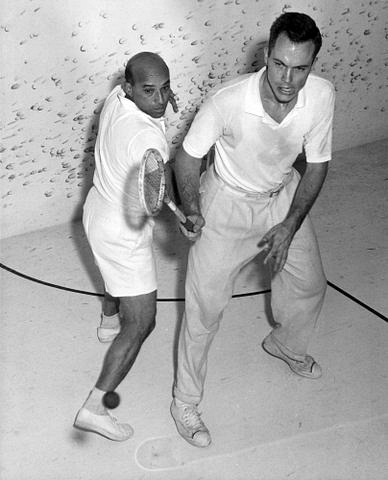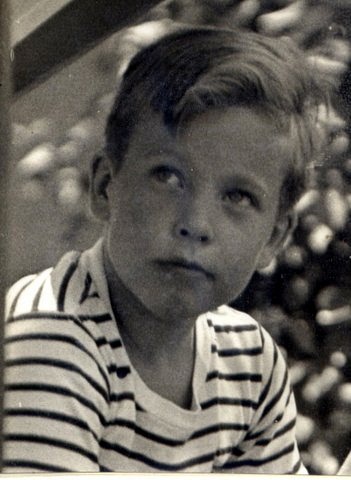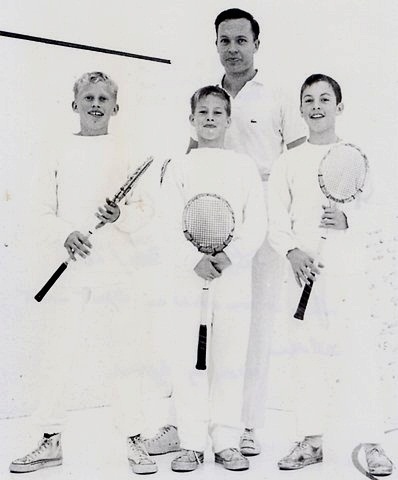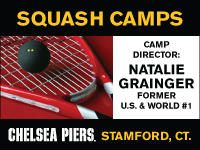G. Diehl Mateer Jr., 6/4/28 – 9/22/12
Record-Setting Champion In The 1950’s And 1960’s
by Rob Dinerman for DailySquashReport.com

Jockeying for position against Hashim Khan circa 1960

Diehl Mateer, right, in the famous 1958 Sports Illustrated cover photo

Left to right: Ben Heckscher, Diehl Mateer, John Hentz, Jim Zug (in back) and Steve Vehslage near the tennis courts at the Merion Cricket Club
Dateline September 24th ---- DailySquashReport.com is sad to report the death this past Saturday of Diehl Mateer, 84, of heart failure. A three-time U. S. National champion, two-time Intercollegiate champion, record 11-time U. S. National Doubles champion, and the only amateur to win the North American Open twice, Mateer was one of the truly great squash players for more than two decades (from the early-1950’s until well into the 1970’s) and literally a first-ballot USSRA Hall Of Famer, having been one the 15 all-time greats who comprised the first class of inductees in 2000. He has also been elected, in each case as well as part of the inaugural group of honorees, into the U. S. Intercollegiate, Haverford College, Maryland State Association and Episcopal Academy Halls Of Fame, and his great and extended series of final-round matches against his contemporary Henri Salaun, especially during the last half of the decade of the 1950’s, made for one of the most memorable and resplendent rivalries in the history of the sport.
All told, they split six National finals during the eight-year period from 1954-61, with each of Mateer’s titles (in 1954, 1956 and 1960) coming at Salaun’s final-round expense, while Salaun prevailed in 1955, 1958 and 1961. Mateer complemented his trio of National titles with North American Open crowns in 1955 and 1959 (defeating Azam Khan and Roshan Khan respectively in those finals), while Salaun won the inaugural 1954 North American Open (and was runner-up to Roshan Khan four years later) and four Nationals.
Between them, they won every one of the 11 editions of the prestigious Harry Cowles event at the Harvard Club Of New York from 1950-60 and all but one of the Canadian Nationals from 1950-59. Mateer buttressed his singles achievements with a record 11 National Doubles titles from 1949-66 with five different partners (Hunter Lott, Calvin MacCracken, Dick Squires, John Hentz and Ralph Howe), while Salaun dominated the National age-group categories throughout the 1970’s, 1980’s and 1990’s to a degree that, barring an absolute miracle, will never be approached, much less equaled.
Their extended rivalry at the very pinnacle of the amateur game must therefore most properly be ruled a draw, which in no way detracts from the fascination it came to acquire not only throughout the squash world but in the larger American community as well. This latter phenomenon was graphically symbolized both by the substantial article that appeared in Life Magazine during the winter of 1954 describing Salaun's unexpected 15-7, 12 and 14 win over Khan in the first-ever North American Open final and, perhaps more significantly, by the cover of the February 10th, 1958 issue of Sports Illustrated, which consisted of a close-up frontal photo of the two stars warming up before yet another final with the caption "Squash Champions Henri Salaun and Diehl Mateer."
As often occurs when two top players become locked in an ongoing series of competitions for their sport's most revered trophies over a significant portion of their overlapping careers, the Mateer-Salaun rivalry developed a unique identity forged in large part by the substantial contrast that existed in personality and playing style between these protagonists. Mateer's game, like the man himself, was built along clean and classic lines and had an all-American golden-boy feel to it in the best sense of the term; blond, muscular and handsome, he was blessed with great power, size, mobility, touch and all-around athleticism, and his fundamentally sound strokes were developed in squash's mecca, the Merion Cricket Club in suburban Philadelphia. He was above all else a power player, who volleyed everything within his long reach and attempted, usually successfully, to physically impose his game on his overwhelmed opposition. Salaun, on the other hand, was small and lean, the personification of economical but effective footwork, who glided, seemingly effortlessly, to the ball and had as well the maddening capacity to place it just enough out of reach to avoid being cut off or retrieved.
He was probably the most astute strategist and counter-puncher in the game and his retrieving, patience, willingness to play long points and deft execution of lobs and front-wall shots (all of which seemed to die just before reaching the far side wall) provided potent antidotes to power players like Mateer, Howard Davis and Stephen Vehslage, all of whom experienced varying degrees of frustration in their attempts to overpower their less imposing adversary with pure heat. Salaun lacked the thunderbolts these sluggers possessed, operating instead with the murderous aplomb of a dinner guest quietly pocketing his host's most expensive silverware.
Whenever he played Mateer, the leading representative of the power game, the question always was which exponent of these diametrically opposite playing styles would prevail on that particular occasion. The undulating quality this rivalry acquired during the 1950's and early 1960's, with neither player ever able to put together a winning streak that lasted more than a few matches, made the outcome of each of their final-round summits impossible to predict and imbued every one of their several-dozen meetings with a tenor of its own.
Mateer’s doubles career had a uniqueness all its own as well, highlighted by U. S. National Doubles triumphs in 1949, 1950 and 1953 with Hunter Lott Jr. (who retired later that same afternoon following the 1953 final), in 1951 with Calvin MacCracken, in 1954 with Dick Squires, in 1958, 1959, 1961 and 1962 with John Hentz and in 1965 and 1966 with Ralph Howe. On the Sunday morning of the 1958 event, Mateer/Hentz saw a 14-6 fifth-game semifinal lead over Howard Davis and James Whitmoyer completely evaporate, but survived when Mateer lashed a drive down the left wall on simultaneous-match-point, following which Mateer and Hentz won a five-game final (15-3 in the fifth) against Paul Steele and Bill Danforth.
Mateer’s organization and focus during a tournament made a lasting impression on several of his partners, who even decades later cited how meticulously he would scout upcoming opponents, how he would arrange formal pre-match sessions to discuss strategy, how he would always hold his racquet on the same side for his forehand, and how he would leaven his approach with an occasional dollop of self-deprecating humor as well. Howe mentioned that once when he and Mateer had already won their semifinal, they sat in the gallery and watched Ian McAvity and Dave Pemberton-Smith win the bottom-half semi, and whenever McAvity would rocket one of his scorching forehands down the middle and nick it out at the back wall, Mateer would lean over to his much younger partner and whisper into his ear, “Those balls are YOURS when he hits them against us!”
Mateer and Howe were thwarted in their bid for a third straight title in 1967 when at 12-all in the first game against Danforth and Howe’s older brother Sam, Mateer, nearing his 40th birthday at the time, ruptured his left Achilles tendon while trying to accelerate in pursuit of a drop shot. He would recover from this injury to reach several other National Doubles finals, including three times (in 1975, 1982 and 1983) with his son Gilbert, a four-time all-American at Penn in the mid-1970’s. Gil would himself win this tournament in 1978 and 1979 with Tom Page (after they had been pressed to five games in a ’79 semi in which there were three Mateers on the court, namely Gil and Page on one team and Diehl and another son, Drew, on the other), in 1980 with John Bottger and in 1986 with his brother Drew. This latter outcome overjoyed Diehl, who had always yearned to have his two sons partner each other to a U. S. National Doubles championship. Drew and Gil would come within a single point of reprising this win two years later, in 1988, before losing,18-17 in the fifth, in the final against Rich Sheppard and Scott Ryan.
In all, the senior Mateer advanced to TWENTY National Doubles finals, a record by a wide margin, beginning with the late 1940’s and extending well into the 1980’s, displaying throughout the adaptability to successfully partner up with a wide range of styles and personalities among his many right-wall teammates. He was always a supportive partner, both on-court and during a match’s aftermath (not always the case when one player has a much better career resume than his partner), and the way he and his Merion contemporaries mentored the next generation (i.e. the Howe brothers and Steve Vehslage), just as Lott had done on his behalf and just as the Howe/Vehslage group would do for the generation after THEM (Bottger, the Page and Mateer brothers, Joe Swain, etc.) played a crucial role in the grand tradition that has come to define that iconic suburban Philadelphia club, beginning even before Mateer’s era and continuing right up to the present.
But for all Diehl’s historic accomplishments in squash and contributions to it, there is universal agreement that his crowning achievement came not in the heated arena of a final-round confrontation but in a private ceremony in a Pennsylvania church in February 1952, when he married Joan Sommer. While Diehl was businesslike and determined, Joan was as warm and welcoming a presence as could be found, an oasis of friendliness and comfort in the maelstrom of a tournament setting, and their 41-year marriage, the five children they raised (Drew and Gilbert, as mentioned, plus Diehl Jr., the eldest, Carver, the only daughter, and Jeff, the youngest), all of whom are married and parents several times over, and all of whom are based in the northeastern corridor, bear enduring testimony to the bond that blessed this devoted couple.
Following Joan’s passing in October 1993, Diehl married Ann Eldridge and they spent 18 happy years together in Virginia. Hers was an extremely supportive presence as Diehl’s health worsened in the spring/summer months leading up to his death this past weekend.

Diehl Mateer, right, with his father, Diehl Sr.

At age 10

In the late 1960’s with sons (left to right) Drew, Gil and Diehl III
Back To Main


